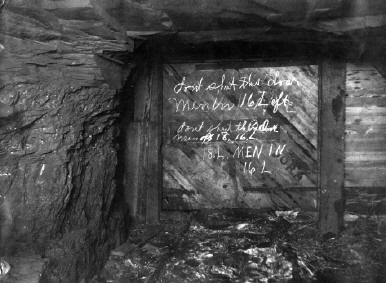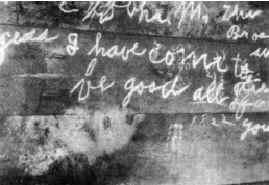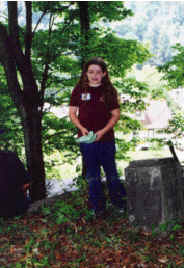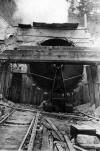NOTICE: 100th
Anniversary Memorial -- Friday, December 9, 2011
View results of the 100th
Anniversary Memorial and Public Tour
View a youtube link of story: http://www.youtube.com/watch?v=yMl9XItQ2IU
and Rescue
Background
Like the Coal Creek War a decade earlier, the Fraterville Mine
explosion of 1902 devastated the Coal Creek watershed. As they had
done after the Coal Creek War, miners and their families rebuilt
from the ashes of the Fraterville Mine explosion. New miners
and their families moved to the Briceville-Fraterville-Coal Creek area, which soon
regained its position as the most populated area in Anderson County,
Tennessee.
View of beautiful Cross Mountain
from Interstate 75 North
in Tennessee today
(6 June 2007)

Click on image to enlarge
October 2005
Turn up your speakers!!
Listen to Tony
Thomas sing the
Cross Mountain Mine Disaster song here
Increased public awareness from disasters like Fraterville, resulted in the formation of the U.S. Bureau of Mines in 1910. Dr. Joseph A. Holmes was appointed as the first Director with a mandate from Congress as follows:
Knoxville and the surrounding areas were able to rebuild after the Civil War faster than many parts of the South due in large part to the manufacturing and mining jobs created by the Knoxville Iron and Coal Company. Cross Mountain was one of their mines and it opened in 1888. By 1911, the Cross Mountain Mine had two power plants to generate electricity for the operation. The main entries and haul ways of the mine were lit by electric incandescent light. Coal was cut by electric chain machines and hauled out of the mine by electric motor cars. Miners loaded the coal onto the cars and used carbide and open oil lamps for illumination. Mules were used to pull coal cars from remote areas to the main entries so the electric motor cars could transport the coal out of the mine.
Friends and relatives awaiting
news
of
the
rescue efforts after
the Cross
Mountain
Mine
explosion in Briceville
on December 9, 1911
Click on image to enlarge
Map of explosion area
in the
Cross
Mountain mine

Headstone of
Eugene Ault
with his farewell
message enscribed
Explosion on Saturday, December 9, 1911
The normal workforce for a Saturday consisted of approximately 125 miners. The fire boss examined the mine that morning and reported nothing unusual. The day engineer who ran the power plants also reported nothing unusual. Only 89 men rode the first mantrip into the mine. The remainder of the workforce remained outside due to a lack of railroad cars that day.
Because the fan was damaged by the explosion, another fan was brought from a nearby mine and assembled at the drift mouth to force air into the mine. Meanwhile, a bonfire was set at the airshaft to induce ventilation out of the mine by throwing bales of burning cotton down the shaft. Also, the fan at the adjacent Thistle Mine where George Camp was superintendent, normally operated as a force fan, but its direction was reversed in an attempt to induce ventilation. Coal pillars had previously been robbed between the two mines causing the ground adjacent to the mines to cave. The effort at Thistle was done to draw out afterdamp (i.e. poisonous gases that form after an explosion) from the Cross Mountain Mine through the caved ground that separated the two mines. It worked. Afterdamp was detected at Thistle 10 minutes after the direction of the fan was reversed. The success of that effort was also evidenced by all the rats in the Thistle Mine being killed by afterdamp.
Americus Alonzo Haynes (Lonzo) and
his son John Frank Haynes
perished in the
Cross Mountain Mine and are buried
together
in Briceville Cemetery.
Photo is Lonzo and his wife Nancy.
Rescue Operation
One of the miners who responded to the explosion was a Welsh miner named Phillip Francis. He had led one of the rescue parties at Fraterville in 1902 and later wrote in a book about his life: A few years after the Fraterville mine explosion, another explosion took place at an adjoining mine called Cross Mountain Mine. A message was sent to me to come at once as they needed rescuers. I left Jellico on the morning train for Coal Creek. Many other miners were on the train. As I arrived near Coal Creek, several miners approached and said to me "We have forty miners on the train going to the mine to help. If you would be our leader we would follow you into the mine. We wondered why you would risk your life going into a closed shop Union Mine. We know you have fought our Union for many years with men having been killed on both sides and the fight still continues". I said "Yes, I have fought you hard, but when I see my fellow miners in distress, I cannot fight them for I am one of you".
Bureau of Mines Rescue Crew
On arriving at the mine, the same sorrowful scene greeted us. Women and children were weeping and all in great distress. Once again, I must control myself and not let my sympathy weaken me. I had work to perform. So I went into the mine with those forty men. It was a drift opening. After going in nearly one mile, I came to a body lying on one side of the entry. Black damp had taken his life. The air was foul. I met a man with a small cage with a dead canary in it. I met another man with a gas mask on and carrying his oxygen with him.

Notice left on door by
barricaded
men
advising
rescuers not to shut them in
The first hopes of men still being alive came when writing on a barricade wall was found that said, “Gone to 22 Right”. Unfortunately, no miners were found alive there. Hope of finding any miners alive was fading.
Then, 58 hours after the explosion, a door was found open at the 18 Left entry that said, “Don’t shut this door, men in 16 Left”. Rescuers found that barricade walls had been built between 16 Left and 17 Left entries. They tore down the barricade wall and tested the air with one of their canaries. Inside, they found three men. One of them was crouched against a wall, smoking his pipe. The others were burned but alive. Later, two other men who had left the barricaded room to attempt escape were also found alive. One of the reasons they had selected their location to await rescue was because it was where tubs had been placed for mules to drink and provided the trapped miners with a source of drinking water.

Barricade opened by rescuers
from
the
Bureau
of Mines
58 hours after the
Cross Mountain
Mine explosion
(Note caged canary
used
to test the air)

Farewell messages of Alonzo Wood
and Eugene Ault were written
on a barricade wall in the
Cross Mountain Mine
Ten days after the explosion, another barricade wall was found with writing on it. Inside, the rescuers found that Alonzo Wood and Eugene Ault had already suffocated. They also found where those miners had written their farewell messages on an adjacent barricade wall before they died. Eugene Ault’s farewell message is inscribed on his headstone in Briceville Cemetery.
A listing of the 84 miners who were killed and the five who were rescued at Cross Mountain, and where they are buried, is attached.
Before he suffocated in the Fraterville Mine in 1902, Powell Harmon wrote: “Dear wife and children, my time has come to die. I trust in Jesus. Teach the children to believe in Jesus. We are all almost smothered. I hope to meet you all in heaven. May God bless you all wife and children for Jesus sake goodbye until we meet to part no more. My boys, never work in the coal mines. Henry and Condy be good boys and stay with your mother and trust for Jesus sake.” Condy Harmon did not follow his father’s advice. He died in the Cross Mountain Mine explosion and is buried next to his father in Longfield Cemetery. In the early 1900's, if you wanted to support your family in Coal Creek, you mined coal. Today, a good education provides students with unlimited opportunities for professions, like Powell Harmon’s great-grandson who graduated from college and owns a computer software development company.
Click on image to enlarge
Arthur T. Scott and
Theodore (Dore) Irish in a
photo taken several years before
their successful rescue in the
Cross Mountain Mine
(Photo courtesy of James Scott)
Cause of Explosion
Although Cross Mountain was classified as a non-gassy mine, methane gas was detected during the subsequent investigation at 25 Left entry. Based on the evidence, a roof fall had occurred at that location which released the gas. The gas apparently ignited when one of the miners approached to examine the roof fall.
Cross Mountain was one of the first successful rescue operation led by the Bureau of Mines. They documented what they found, compiled lessons-learned, and developed methods to reduce the potential for future disasters. Their success at rescuing the miners at Cross Mountain led to continued funding and allocation of resources which have resulted in safer working conditions for miners today.

Farewell message of Eugene Ault
being
read
over
his grave: "Air is not
much now.
All be good
and I
aim to pray to God to
save
me and all
of you. Tell Clarence
to
wear
out my clothes.
Give Bessie Robbins
a stickpin
of mine. Tell
her goodbye." (Clarence was his brother
and
Bessie Robbins was his girlfriend)
LEGACY
Mine safety is now the mandate of the Mine Safety and Health Administration (MSHA) that led the successful rescue of miners trapped in the flooded Quecreek Mine in Pennsylvania in 2002. Coal mining is no longer on the list of most-dangerous professions in the U.S. In 1911, 2,656 miners lost their lives in the Nation's coal mines. Last year, 28 coal miners died nationally while producing the coal that provides over half of the electricity used in this country.
Attempts to portray the Coal Creek miners as poor and abused do them a disservice. They came to Coal Creek from as far away as Wales to seek a future for themselves and their families. Nobody held guns to their heads making them work in the coal mines. To the contrary, when their neighbors started losing their jobs to the convict lease system, they literally went to war to protect the mining jobs in Coal Creek.
The legacy of the Coal Creek miners....fueled the industrial revolution, abolished the convict lease system in the South, and made working conditions safer for future miners.... rivals that of any comparable group its size in history.
 Patrick
and Melda Vallalay
Patrick
and Melda Vallalaywith their daughter
Beulah about 1904
 Patrick
Vallalay (center standing). His brother Charles died in the 1902
Fraterville explosion and his brother Henry Tate died with Patrick in the
1911 Cross Mountain explosion.
Patrick
Vallalay (center standing). His brother Charles died in the 1902
Fraterville explosion and his brother Henry Tate died with Patrick in the
1911 Cross Mountain explosion.,%20Melda,%20Grace,%20Beulah,%20Jeff(Elnor)_small.jpg) Melda
Vallalay (seated) and her children Beulah, Elnor, Pearl, and Grace, shortly
after her husband Patrick died in the 1911 explosion. Bessie Hatmaker,
Melda's sister, may be the one standing behind her. Bessie later
married Albert Vowell who may have been the young boy standing at the mouth
of a mine during the Coal Creek War,
which appears in
the Tennessee Blue Book, a History of Tennessee.
Melda
Vallalay (seated) and her children Beulah, Elnor, Pearl, and Grace, shortly
after her husband Patrick died in the 1911 explosion. Bessie Hatmaker,
Melda's sister, may be the one standing behind her. Bessie later
married Albert Vowell who may have been the young boy standing at the mouth
of a mine during the Coal Creek War,
which appears in
the Tennessee Blue Book, a History of Tennessee.
Miner James Foust holding Clarence,
Laura Foust and little Bertha

Miner Calvin French Leinart
Lewis Teno and
children,
Delsie and Claud
Photo taken at J.T. Brooks grocery store in Briceville one year before the Cross Mountain Mine disaster. Three men shown here lost their lives in Cross Mountain: John Polston, 4th from left on the back row; Jim White, 4th from left on the front row, and Arthur Smith, 2nd from right on front row
Entrance of Cross Mountain Mine
in Slatestone Hollow
pictured years after the explosion

Remnants still remain of the
old air shaft
at Cross Mountain Mine
Popular Mechanics
Magazine (March 1912) discussing advancements in
mine safety made as a result of the Cross Mountain Mine Rescue operation
CLICK ON IMAGES TO ENLARGE
Coal
People Magazine article
January / February 2012
Message from the Darkness
 (Back
row L to R):
(Back
row L to R):Charles Herbert Irish and George Elbert Irish
(Front row L to R):
Horace Augustus Irish and William Reuben Irish
George was a leader of the miners during the Coal Creek War and his brother H. A. died in the Cross Mountain Mine Explosion
 Photo
taken after
Photo
taken aftermine explosion
after the December 9, 1911
Cross Mountain Mine Explosion in Briceville, TN:








References
Briceville Through the Years, Gene White, Action Printing, Ltd., 1994.
Seventy Years in the Coal Mines, Philip Francis, 1936.
Historical Summary of Mine Disasters in the United States, Mine Safety and Health Administration, 1998.
Tennessee’s Coal Creek War, Chris Cawood, Magnolia Hill Press, 1995.
Circling Windrock Mountain, Augusta Grove Bell, University of Tennessee Press, 1998.
Anderson County, Tennessee, A Pictorial History, James Overholt, Donning Company Publishers, 1989.
Coal Creek/Lake City Visions of the Past, Charles Winfrey, 1986.
A New South Rebellion, Karen A. Shapiro, University of North Carolina Press, 1998.
Explosion at Cross Mountain Mine, Briceville, TN, by J. J. Rutledge, Mining Engineer, U.S. Bureau of Mines, July 19, 1912.
Coal Creek Watershed Foundation, Inc. web site www.coalcreekaml.com.

